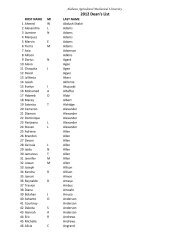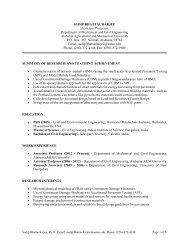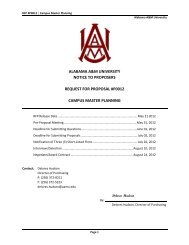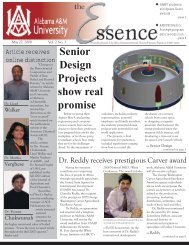LogoFinal <strong>Report</strong>: 0420541Product Description:A CFEA Logo and letterhead were developed and distributed to CFEA personnel for use in email and written correspondence. Magnetic Logoswere distributed to place on bumpers and vehicles for use in the field. Tote bags, pencils, key chains, rulers, and lanyards were given to eachattendee of the CFEA Summer conference. In addition, visitors to the Center and Partners were provided with these items in appreciation fortheir support of CFEA.Sharing Information:Available to everyoneProduct Type:brochuresProduct Description:CFEA brochures were developed and CFEA logo materials were provided at all recruitment efforts. CFEA graduate students who went onrecruitment trips were reimbursed through matching funds and the BWWB Grant.Sharing Information:conferences and recruitmentContributionsContributions within Discipline:CONTRIBUTION WITHIN DISCIPLINECFEA investigators were successful during last six years in seeking funds to develop additional areas of research related to impacts of forestmanagement on the forest ecosystem in northern <strong>Alabama</strong>. These areas include water quality, invasive plants, outdoor recreation, forestfragmentation, harvesting impacts on humans, forest site mapping and classification, and impacts on additional animal communities includingaquatic communities.THRUST AREA I: FLORAThe knowledge gained about vegetation dynamics and the information anticipated to be gained after the subsequent growing seasons is likely tostrengthen the ability to manage the forest at the ecosystem level. It will also provide us the means to quantitatively anticipate the impact ofsilvicultural operations on plant succession and the change in plant cover, richness, diversity, and other vegetation characteristics of importanceto the ecosystem functioning. The results will enable us to design and use the most effective treatments when we aim for bringing back thenative vegetation and with it, the birds, reptiles, amphibians, and other organisms that used to occur on those sites prior to conversion to pastureand later to pine plantation.Our work resulted in a number of findings that are important contributions to our knowledge in the field of plant ecology. Analysis of date fromthe ground layer vegetation showed that a total of at least 70 systematically distributed plots, 1 meter sqaure each, are sufficient to capture atleast 90% of the species in a forest ecosystems of the type studied. Additionally, our analyses demonstrated that explaining the compositionalvariation of the three studied life forms (vines, herbs, and graminoids) was better accomplished using non-linear methods.The studied treatments (thinning, burning, and a combination of the two) have different effects on the ground layer plant community.Moreover, they have a different impact on the cover, richness, and diversity of the plants, depending on the plant life form. The treatments alsointeracted with each other, resulting in an increase complexity of the vegetation response.Our research revealed that the season in which the sampling occurred had a significant effect on the vegetation cover and richness, but not ondiversity. Therefore, season of sampling is a crucial consideration of in studies that aim to examine plant cover and richness, regardless of thetreatments applied. Additionally, it is important to also account for the significant interaction between the season of sampling and the treatmentthat was observed in our study.THRUST AREA II: FAUNAThe fauna thrust area has contributed much to our understanding of the ecosystem response to the forest disturbance we are studying. Theanimal communities are early indicators of the effects of forest disturbance in the ecosystem. Our results suggest that the thinning disturbancehad a greater impact, with few exceptions, than prescribed burning, thus far. The intensity of the thinning treatments may be responsible for ourobservations, but the frequency of the prescribed burning may still combine with thinning to produce different results than either disturbancealone. Our data collection must continue to detect the potential divergence of the animal communities under different disturbance regimes.Page 53 of 58
Final <strong>Report</strong>: 0420541Previous studies of animal community responses to these types of disturbances are rather limited because of the difficulty of conducting a largereplicated field experiment with pretreatment data and controls. Thus, our findings for particular animal taxonomic groups will make significantcontributions to those disciplines because of the comprehensive experimental design we have chosen. We are even finding that some of thecreatures we are studying were thought to be rare in the State are fairly common once we began to conduct our intensive surveys and studies.We are confident that, in the long term, we will be able to contribute information on recovery period, threshold dynamics, and causalmechanisms to the disturbance ecology literature that is rare or lacking for some animal groups that are important components of the forestecosystem.Our search for mechanisms in observed responses has been mostly successful thus far, but not completely satisfactory. Some animalcommunity groups have less certainty about causal factors in explaining the ecological effects of the disturbances. Also, long term effects ofdisturbance may negate initial positive responses as environmental conditions change and weaken our perceived causal relationships. Ourincomplete understanding is not surprising given the complex nature of ecological relationships and our relatively short investigation of thisdisturbance regime.Beyond this view of our contribution to other disciplines, our Center has made some concrete contributions by expanding the scope of ourresearch to additional faunal components of the ecosystem to include the disciplines of herpetology and aquatic ecology. We anticipate thatthese will further add to our own internal synergy between taxonomic groups as we seek to determine the patterns of faunal response to forestecosystem disturbances and the underlying mechanisms that are responsible for those patterns. As our Center develops further, it is likely thatadditional animal communities may be represented that will fill in missing links and further our understanding of the deeper ecological patternsand processes regarding the dynamics of competition, predation, regeneration, migration, and other ecological areas of scientific exploration.THRUST AREA III: SOILSForest ecosystems play critical roles in the global C management, which is thought to affect green house gases and global warming. Since thecapacity of forest ecosystems to sequester C depends to a large extent on the ecosystem management practices, this research addresses one ofthe critical issues of our time ??'global soil C sequestration. Prescribed fire has been a forest management tool for hundreds of years for very good reasons: Native Americans used fire to create distinctlandscape patterns; forest managers have used low intensity burns to maintain fire dependant species, improve wildlife habitat, and prepare sitesfor seeding. But in spite of the wealth of knowledge that is currently available regarding forest management (specifically prescribed fires), andsoil C sequestration, there are still uncertainties due to current methods of assessing C sequestration in soils. This problem has led to differentconclusions in the literature. Many studies have suggested that frequent fires can deplete the organic litter layer and leave the mineral soilvulnerable to soil degradation and that forest harvesting on average has little or no effect on soil C and N. But other studies have not foundsignificant differences in C sequestration. Our research employs a pedological approach that analyzes research sites based on climate, organisms, topography, parent material, and time(clorpt). The approach also studies entire soil profiles by examining soil pits to determine the smallest C changes in the soil layers. Thereforethis study is contributing significantly to our current knowledge of ecosystem management and global C accumulation studies.Several research presentations in national and international meetings and conferences have been and will continually be done. A MS levelthesis titled: 'CARBON SEQUESTRATION IN A DISTURBED FOREST ECOSYSTEM OF NORTHERN ALABAMA'?has been completed,based entirely on the data generated from this study. One manuscript titled 'INITIAL RESPONSE OF SOIL NUTRIENT POOLS TOPRESCRIBED BURNING AND THINNING IN A MANAGED FOREST ECOSYSTEM OF NORTHERN ALABAMA' has been publishedin the highly rated Soil Science Society of America Journal (Soil Sci. Am. J. 73: 285-292). Another is being prepared for the highly rated SoilScience Journal. Part of a PhD dissertation titled 'SOIL BIOGEOCHEMISTRY OF TRACE METALS IN ALTERED ECOSYSTEMS' wascompleted based on data from Objective #7 of the Biogeochemical Group. That PhD work evaluated the impacts of prescribed forest fires andlogging on trace metal release and redistribution in the ecosystem. In all, this research is making great contributions in the discipline of soil andenvironmental sciences.THRUST AREA IV: MOLECULAR BIOLOGYThe findings from this research help us in identifying genetic bottlenecks, while developing diagnostic genetic markers for detection ofindividual species. As the inter-specific hybridization within red oaks is very common, we may be able to set up large-scale population geneticsexperiments to determine the significant locations in the oak genome that influence the important traits. Our current collaborations are alreadyworking to develop additional markers using next generation sequencing and bioinformatics for developing detailed genetic maps of red oakgenomes. THRUST AREA V: HUMAN DIMENSIONSThis research addressed one of the emerging themes in the global research-human dimensions of natural resources management by utilizing thePage 54 of 58
- Page 1 and 2:
Center of Forest Ecosystem Assessme
- Page 3: Final Report: 0420541specialties. T
- Page 6 and 7: Worked for more than 160 Hours:YesF
- Page 8 and 9: Final Report: 0420541bird surveys u
- Page 10 and 11: Final Report: 0420541Dimov. Joel gr
- Page 12 and 13: Final Report: 0420541and is current
- Page 14 and 15: Final Report: 0420541Name: Shelton,
- Page 16 and 17: Worked for more than 160 Hours:YesF
- Page 18 and 19: Final Report: 0420541Contribution t
- Page 20 and 21: Worked for more than 160 Hours:YesF
- Page 22 and 23: Final Report: 0420541Name: Watson,
- Page 24 and 25: Final Report: 0420541workshop, Fore
- Page 26 and 27: Final Report: 0420541Name: Brown, J
- Page 28 and 29: Final Report: 0420541our mutually b
- Page 30 and 31: Final Report: 0420541Eric Soehren -
- Page 32 and 33: Final Report: 0420541Lawson, D. S.,
- Page 34 and 35: Final Report: 0420541Hupp, N., Dimo
- Page 36 and 37: Final Report: 0420541and How to Con
- Page 38 and 39: Final Report: 0420541Worldwide GIS
- Page 40 and 41: Final Report: 0420541Students are u
- Page 42 and 43: Final Report: 0420541AAMU 'local ar
- Page 44 and 45: Final Report: 0420541Felix, Z., L.
- Page 46 and 47: Final Report: 0420541Dimov, L.D., J
- Page 48 and 49: Final Report: 0420541Chen, X, Barro
- Page 50 and 51: Final Report: 0420541Baldwin, T., C
- Page 52 and 53: Product Type:Data or databasesFinal
- Page 56 and 57: Final Report: 0420541indicators of
- Page 58 and 59: Final Report: 0420541The proposed B
- Page 60 and 61: Research ActivitiesThe multi-discip
- Page 62 and 63: 4 m 2subplot sizeTreatmentStand( >
- Page 64 and 65: Color Infrared (CIR) imagery was ob
- Page 66 and 67: easy access to the bait. Three pair
- Page 68 and 69: was 50 m from the edge of the stand
- Page 70 and 71: individual. Age class was categoriz
- Page 72 and 73: two meter piece of 1.9 cm diameter
- Page 74 and 75: accessed and monitored with the res
- Page 76 and 77: artificial or natural and if water
- Page 78 and 79: forested site. The natural history
- Page 80 and 81: increased mortality from dessicatio
- Page 82 and 83: and particular variables that were
- Page 84 and 85: literature seem unlikely to be appl
- Page 86 and 87: Soil samples were collected from re
- Page 88 and 89: With the optimized protocols for ex
- Page 90 and 91: compiled a report, presentation, an
- Page 92 and 93: mosaicked. This digital data was us
- Page 94 and 95: andomly selected individuals with a
- Page 96 and 97: data was collected using a cone pen
- Page 98 and 99: consists of two lectures and a 5-ho
- Page 100 and 101: included four females. This increas
- Page 102 and 103: during the summer in the field and
- Page 104 and 105:
Each year the students were trained
- Page 106 and 107:
We then teamed with a minority educ
- Page 108 and 109:
Figure 8: AAMU and NFU meetingSept
- Page 110 and 111:
Major Research FindingsDuring the l
- Page 112 and 113:
2. Determine the effects of oversto
- Page 114 and 115:
it was rooted in the subplot. Groun
- Page 116 and 117:
1412Stems per acre1086450_pre75_pre
- Page 118 and 119:
Within the 0.025 plots, we could no
- Page 120 and 121:
Table 5: Cover and frequency of the
- Page 122 and 123:
Mean Cover Change %0.20.0-0.2-0.4-0
- Page 124 and 125:
There was a significant interaction
- Page 126 and 127:
There was a significant change in o
- Page 128 and 129:
esulting classified CIR photograph
- Page 130 and 131:
Table 10: List of identified ant sp
- Page 132 and 133:
-1.0 1.0Axiscancov2LegendSpecieslit
- Page 134 and 135:
Figure 11: Litter depth interaction
- Page 136 and 137:
Figure 15: Interaction between burn
- Page 138 and 139:
microhabitat characteristics, arthr
- Page 140 and 141:
3. Small mammalsWith the help of gr
- Page 142 and 143:
Small Mammals (2005-2007)We also ex
- Page 144 and 145:
arefaction plots indicate that spec
- Page 146 and 147:
Figure 23: Total heliothermic lizar
- Page 148 and 149:
Figure 25: Total frog captures of t
- Page 150 and 151:
Table 18: Overall canonical corresp
- Page 152 and 153:
Figure 27: Canonical correspondence
- Page 154 and 155:
Figure 29: Canonical correspondence
- Page 156 and 157:
Figure 31: Canonical correspondence
- Page 158 and 159:
egan filling in January and Februar
- Page 160 and 161:
Species Richness and AbundanceThere
- Page 162 and 163:
Table 23: Comparisons of total capt
- Page 164 and 165:
pools at which they were present. A
- Page 166 and 167:
Warbler (KEWA), Canada Warbler (CAW
- Page 168 and 169:
Figure 38: Canonical correspondence
- Page 170 and 171:
7. Aquatic ResourcesData collection
- Page 172 and 173:
Treatment 4- Thin OnlyConcentration
- Page 174 and 175:
did not appear to influence differe
- Page 176 and 177:
The concentration of amino acid nit
- Page 178 and 179:
Figure 48: Amount of amino sugar ni
- Page 180 and 181:
were both identified. In addition t
- Page 182 and 183:
environment. These compounds are ge
- Page 184 and 185:
Figure 51: Organisms identified as
- Page 186 and 187:
Burn OnlyPercent Weight100908070605
- Page 188 and 189:
Figure 57: (a) Bicarbonate extracta
- Page 190 and 191:
Control (a)Treatment 3 (b)Treatment
- Page 192 and 193:
instance, the ratio of diester: mon
- Page 194 and 195:
6. Total C and NPrescribed burning
- Page 196 and 197:
Figure 66: Mean total N concentrati
- Page 198 and 199:
Figure 68: Screening of SSR primer
- Page 200 and 201:
F14-700 Black OakM 1 2 3 4 5 6 7 8
- Page 202 and 203:
Three different geodatabase sets we
- Page 204 and 205:
income inequality, manufacturing jo
- Page 206 and 207:
esult was not expected because seve
- Page 208 and 209:
the importance of environmental con
- Page 210 and 211:
Respondents having evidence of trus
- Page 212 and 213:
treatments were not much different
- Page 214:
determined that our graduate progra
















